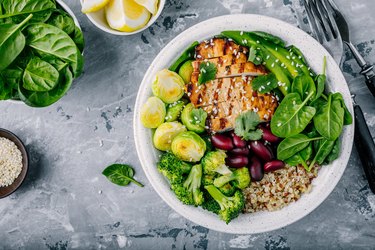
Eating three meals a day seems sensible, but is it healthy? When you want to feel and look your best, it's hard to ignore the conflicting claims that grazing all day or skipping meals is the best way to reach your goals. This is one case where it may be healthiest to stick with tradition.
Tip
Eating three meals a day helps keep energy levels up and hunger at bay.
Video of the Day
Meal Frequency and Weight
The average American eats about 2.8 meals a day, and a three-meals-a-day pattern is the norm in other industrialized nations. There is no clear, consistent evidence that any other meal frequency is better. In 2011 position stand, the International Society of Sports Nutrition reported that spreading calories out over more than three meals doesn't appear to favorably change body composition. The benefits of eating 3 meals a day, with no snacks or only healthy snacks, may be optimal for controlling appetite and managing food intake.
Video of the Day
Aiming for Optimal Calorie Distribution
One advantage of eating 3 times a day is that you are spreading your calories across your day, so you don't get too hungry between meals. Another is that you aren't spreading your calories too thin, so you are more likely to feel satisfied after each meal. Grazing all day may cause you to loose track of calories, especially if you choose high-calorie snacks, while having fewer than three meals a day may leave you so hungry that it's hard to make healthy food choices.
Meal Quality Versus Meal Quantity
What you eat probably makes more of a difference than how often you eat. Skipping meals can make it hard to get the variety of foods and nutrients you need for good health. When you eat breakfast, lunch and dinner, you are likely to choose different foods at each meal, providing overall variety. Snacking can be a good way to add extra servings of fruits, vegetables, whole grains and healthy protein to your diet, or it can be an excuse to eat potato chips and candy bars.
What Three Meals a Day Looks Like
The following suggestions can help keep you feeling satisfied so that you'll limit your in-between meal snack time.
A breakfast of oatmeal with peanut butter and raisins provides the protein, whole grains and fruit you need to kickstart your day. For lunch, a tuna-cucumber wrap has needed protein and veggies, accompanied by vanilla yogurt, which has plenty of calcium. A dinner of honey lemon chicken, brown rice pilaf, peas and corn also provides protein and veggies. Supplemented by a snack of carrot sticks, hummus and whole grain crackers, this is a typical way of getting most of your nutrients in three meals and a healthy snack, without going hungry.
No Snacks or Few Snacks
Determining whether three meals a day is a healthy pattern for you may take some experimentation. Your goal is to provide your body with steady energy throughout the day and to get hungry enough between meals that you feel ready to eat but are still able to make rational choices at mealtime. If you find that you get too hungry between meals, adding a snack or two while still staying within your ideal calorie range may be a better option for you.
- Obesity Review: Selected Eating Behaviours and Excess Body Weight: A Systematic Review
- Journal of the International Society of Sports Nutrition: International Society of Sports Nutrition Position Stand: Meal Frequency
- ChooseMyPlate: Sample Two-Week Menus
- Food & Nutrition: Meal Frequency Around the World: What Can We Learn from Other Cultures?
- NCBI: 40-year trends in meal and snack eating behaviors of American adults